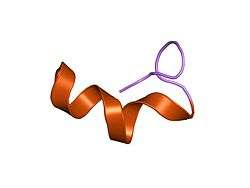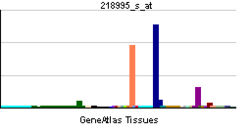Endothelin 1
| View/Edit Human | View/Edit Mouse |
Endothelin 1 (ET-1), also known as preproendothelin-1 (PPET1), is a protein that in humans is encoded by the EDN1 gene. The protein encoded by this gene is proteolytically processed to release a secreted peptide termed endothelin 1. This peptide is a potent vasoconstrictor and is produced by vascular endothelial cells. Endothelin 1 is one of three isoforms of human endothelin.
Preproendothelin is precursor of the peptide ET-1. Endothelial cells convert preproendothelin to proendothelin and subsequently to mature endothelin, which the cells release.[3]
Endothelin-1 receptor antagonists (Bosentan) are used in the treatment of pulmonary hypertension. Inhibition of these receptors prevents pulmonary vasculature constriction and thus decreases pulmonary vascular resistance.
References
- ↑ "Human PubMed Reference:".
- ↑ "Mouse PubMed Reference:".
- ↑ Boulpaep EL, Boron WF (2009). Medical physiology: a cellular and molecular approach. Saunders/Elsevier. ISBN 1-4160-3115-4.
Further reading
- Bruno CM, Neri S, Di Prima P, Sciacca C (2003). "Pathophysiology of endothelin and medical emergencies.". Panminerva medica. 45 (2): 151–4. PMID 12855940.
- Doggrell SA (2006). "The endothelin system and its role in acute myocardial infarction.". Expert Opin. Ther. Targets. 8 (3): 191–201. doi:10.1517/14728222.8.3.191. PMID 15161426.
- Beghetti M, Black SM, Fineman JR (2005). "Endothelin-1 in congenital heart disease.". Pediatr. Res. 57 (5 Pt 2): 16R–20R. doi:10.1203/01.PDR.0000160447.83332.13. PMID 15817494.
- Cazaubon S, Deshayes F, Couraud PO, Nahmias C (2006). "[Endothelin-1, angiotensin II and cancer]". Med Sci (Paris). 22 (4): 416–22. doi:10.1051/medsci/2006224416. PMID 16597412.
- Ariza AC, Bobadilla NA, Halhali A (2007). "[Endothelin 1 and angiotensin II in preeeclampsia]". Rev. Invest. Clin. 59 (1): 48–56. PMID 17569300.
- Davenport AP, Hyndman KA, Dhaun N, Southan C, Kohan DE, Pollock JS, Pollock DM, Webb DJ, Maguire JJ (April 2016). "Endothelin". Pharmacological Reviews. 68 (2): 357–418. doi:10.1124/pr.115.011833. PMID 26956245.
This article incorporates text from the United States National Library of Medicine, which is in the public domain.

